Battle of Ginegate: personal victory of the future Emperor Maximilian I
Historical the battle. Battles of knights with knights or knights with infantry is always interesting. This is excitingly interesting, especially if we imagine how such battles took place. Imagine that you are holding a peak five meters long and push it to the ground with your foot. It is clear that you are not alone: your comrades are in the same poses on the right and left. Knightly cavalry rushes - “lava” of people and horses, chained in iron. It’s one thing - the transitional era from chain mail to plate armor, when metal was practically not visible on the knights - blankets, gambizons, helmet-mounted lambrequins, but at the end of the XV the polished metal dominated the battlefield. And such "iron guys" on the "iron horses" will jump on you, and you need to stop them. The Japanese book “Monogotari Zobie” describes how an infantryman feels with a lance in his hands when he sticks it in the horse’s neck and what is required of him at that time ... “Like a giant pulls a lance out of your hands ...” - that’s the feeling. But you need to try to keep the peak, then pull it out of the fallen horse and try to stick it in the next! And the knights - they, too, are not the lamb in the slaughter, try to get into the breaks of the peak, prick you with their spears, chop with swords, there is a clink of iron and a neighing horse, and, of course, they still scream, scream out loud!
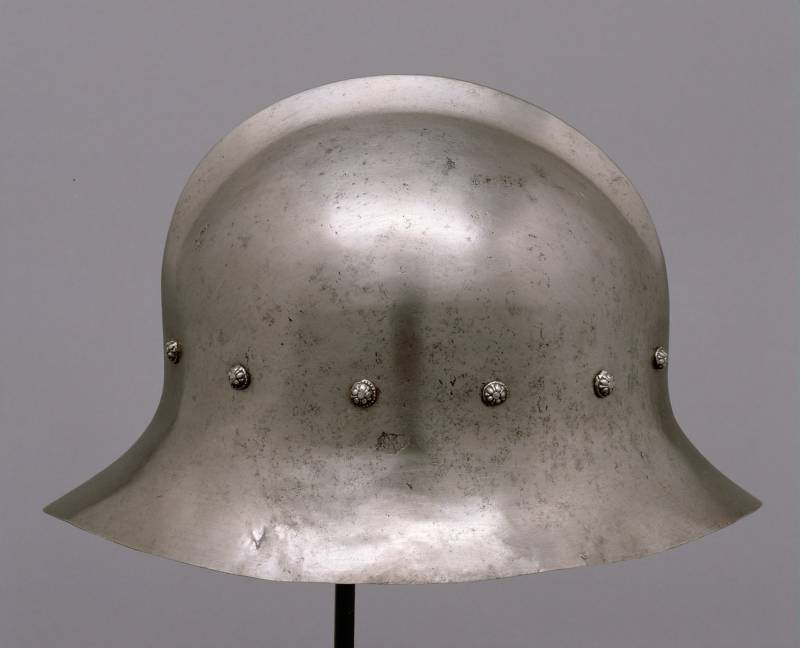
"Iron Hat" (chapel-de-fer) Approx. 1470-1480 Milan. Too many foot soldiers participating in the battle of Ginegat wore such “hats” on their heads (Vienna armory Ward)
That's about one of the battles “at the turning point” of the epochs - the battle of Ginegat on August 7, 1479 - the battle between the allied Habsburg and Dutch troops and the French army during the war for the Burgundian inheritance. And, I think, it will be very interesting for VO readers to get acquainted with how it happened, since we have already examined here the armor of Emperor Maximilian I, as well as his biography, learned about the war for the Burgundian inheritance, and now it would be logical to get acquainted with one from the battles of this era.
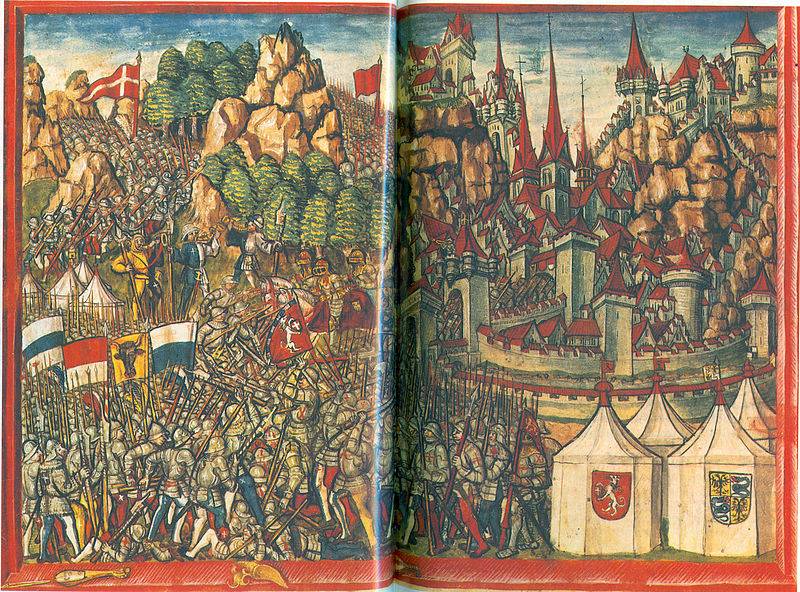
Battle of Arbedo (1422). Miniature from The Chronicles of Lucerne (1513) (Central Library, Lucerne)
In 1478, hostilities mainly went to the provinces in Picardy. The parties did not succeed, and as a result, on July 11, they concluded a ceasefire for a period of one year. Yes, yes, then they fought like that. Louis XI was very afraid of the intervention of the Holy Roman Empire in this conflict, and in order not to give a reason for it, he decided to withdraw his troops from Hainaut, and also promised to return Franche-Comté, which he failed to completely capture. However, he did not refuse the main thing, that is, the duchy of Burgundy, and in addition he also declared that he would continue to title Maria of Burgundy and Maximilian of Habsburg only as the Duchess and Duke of Austria, but no more.
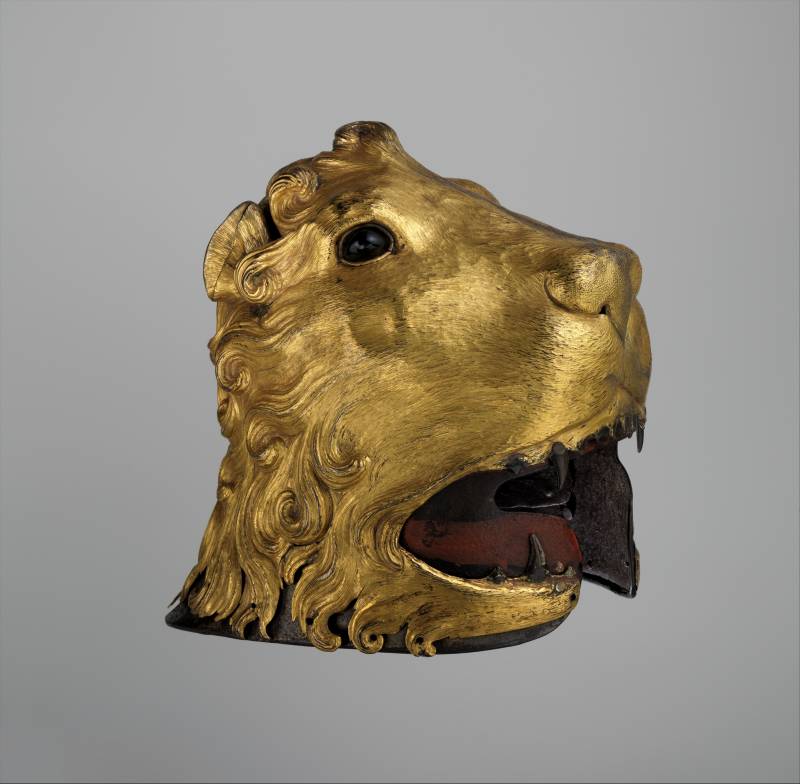
A rare type of helmet is sallet or salad: “Sallet the lion's head” 1475–80. Italy. Steel, Copper, Gold, Glass, Textiles (Metropolitan Museum of Art, New York)
At Franche-Comté, the truce, however, did not extend. And Louis XI thought, and decided that there was no point in returning this territory, and words, these are just words, and if so, then it should continue its conquest. And already in the spring of 1479, large French forces moved there. At the same time, in Picardy and Artois, both ordonance companies and also free arrows (“franc archers”) of Marshal Gier and seigneur de Corda. However, they did not have enough forces to conduct an offensive operation. Archduke Maximilian took advantage of this, who quickly gathered an army of 27 thousand people and on July 25 approached the city of Teruana. Apparently, he wanted to succeed in Picardy even before the reinforcements from Franche-Comté came to the aid of the local units.
Teruana's city garrison was commanded by the lord de Saint-Andre. Under his command there were 400 “spears” and 1500 crossbow shooters — that is, sufficiently large forces. When the Imperials surrounded the city and began shelling, it was reported that the French army was coming to the rescue. Maximilian immediately convened a council of war, at which many of his commanders expressed doubt that their troops, consisting of Flemish militias, would be able to withstand the blow of French horse armor. However, the duke, who was also supported by his younger associates, nevertheless decided to give the French a battle. Heavy bombards were abandoned, and only light coolers were taken to participate in the field battle.
The French army, although inferior to the enemy in numbers, had a large number of heavy guns. Among them, the recently molded “Big Bourbonka” cooler was especially notable, that is, the French side had the advantage here. Their army took up positions between the hills, in a place that the locals called Ginegat. The army was commanded by the lieutenant general of King Louis XI, Philippe de Crevker, senor de Cord, a Burgundian by birth and a knight of the Order of the Golden Fleece.
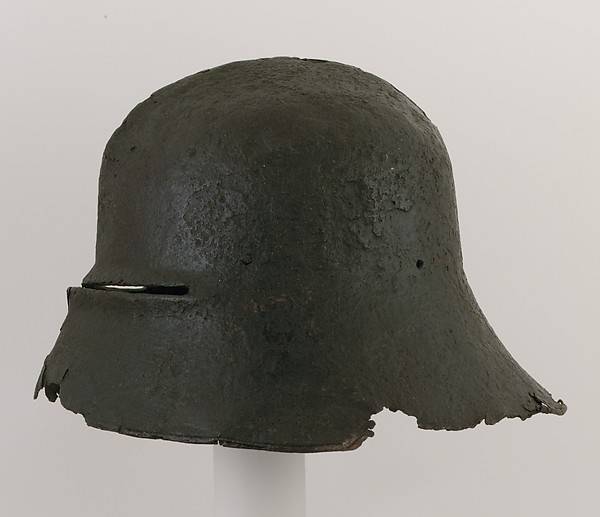
Such salads were most often worn by foot soldiers. OK. 1450 g. Weight 2984 g (Metropolitan Museum of Art, New York)
The number of the French army was 1800 “copies” and 14000 “francs arsher”, although the data of different historians are slightly different. Archduke Maximilian built the Flemings in the form of an extended phalanx of great depth, exposing before it 500 hired English archers under the command of the knight Thomas Origan, who had fought for Karl the Bold, and as many as three thousand of his German arquebusiers. His heavily armed cavalry, which was numerically inferior to the French, he divided into several small units of 25 horsemen in each, so that they supported the infantry flanks. Among the riders of this cavalry there were many noble Flemish lords and those of the Burgundians who remained faithful to Mary and Maximilian.
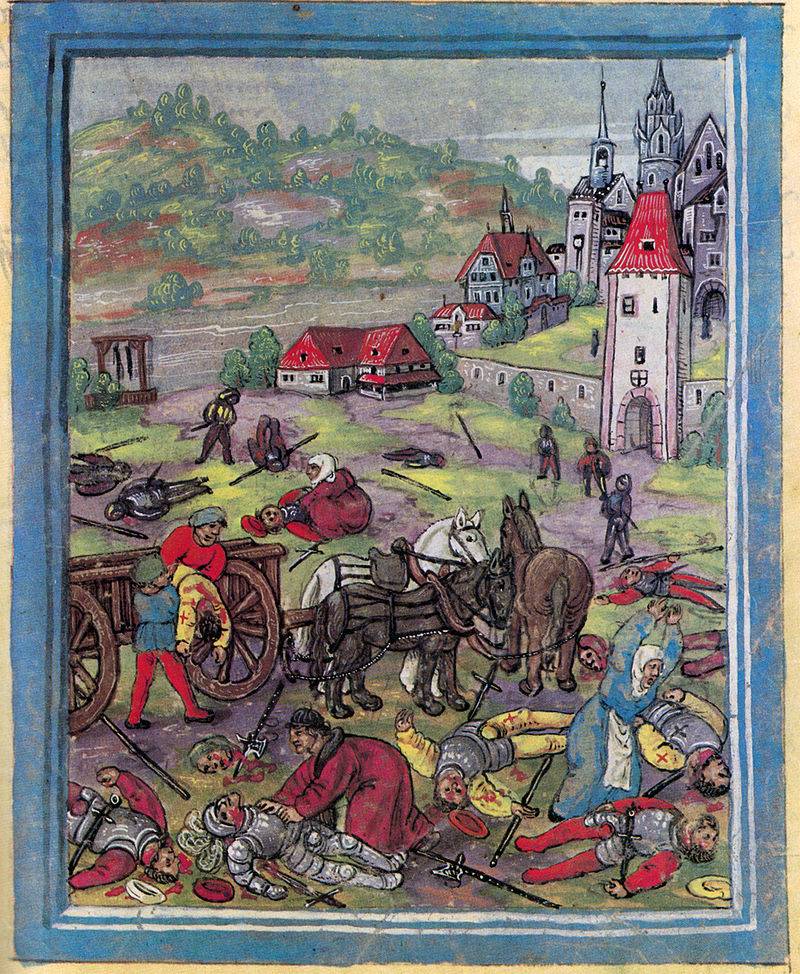
Women and priests retrieve the corpses of Swabian soldiers immediately outside the city gates after the Battle of Triboltingen during the Swabian war. Thumbnail from the manuscript of Dibold Schilling the Younger. (Central Library, Lucerne)
Modern chronicles report that the duke addressed his soldiers with a sensual speech before the battle, in which he urged them to return everything taken away by the French and “restore justice”, to which his troops allegedly answered amicably: “So we will do it!” But here it should be noted that since the French plundered Flemish cities and villages, the Flemings were not particularly required to be brought to battle - they already hated the French with all their hearts.
The battle began quite traditionally: the English archers who stood in front crossed themselves, kissed the ground - such was their strange custom, and started firing at the French with shouts: “St. George and Burgundy!” At the same time, they opened fire and light coolers, which turned out to be more effective, rather than the heavy cannons of the French.
Seeing that his troops were suffering losses, Philippe de Krevkør sent a detachment of six hundred spears and part of the crossbowmen bypassing the enemy’s right flank. Flemish gendarmes came out to meet them, and at first they managed to repel their attack. But the numerical advantage of the French soon affected, and the second attack of the French was crowned with success: the Flemish cavalry was defeated, the guns of the Burgundians standing on the left flank were captured.
After that, the remains of the Flemish cavalry fled, and the French gendarmes began to pursue them. Of course, this was a big mistake, but it was simply impossible to keep them from doing this, because everyone understood that for the noble riders, of whom there were many, it was possible to get a big ransom. And it is not surprising that then many representatives of the Burgundian nobility, who spoke on the side of Maximilian, were captured, and Philippe de Trizeni, dressed in gilded armor, and even decorated with diamonds, the French pursued right up to the city of Era, believing that they were chasing Maximilian himself .
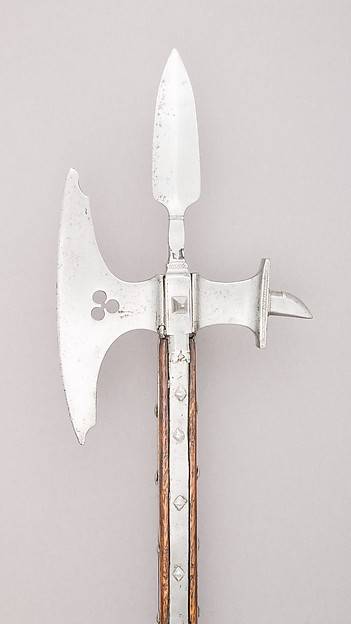
Polex, approx. 1450 g. Weight 2466,4 g (Metropolitan Museum of Art, New York)
The historian Philippe de Commin reports that not all the royal cavalry went off to pursue the retreating Flemings, but with it the commander and seigneur de Torsi, who was hardly worth doing this, had to continue to command the whole the army. Whatever it was, but it happened. As a result, the Flemish infantry on the left flank escaped complete defeat.
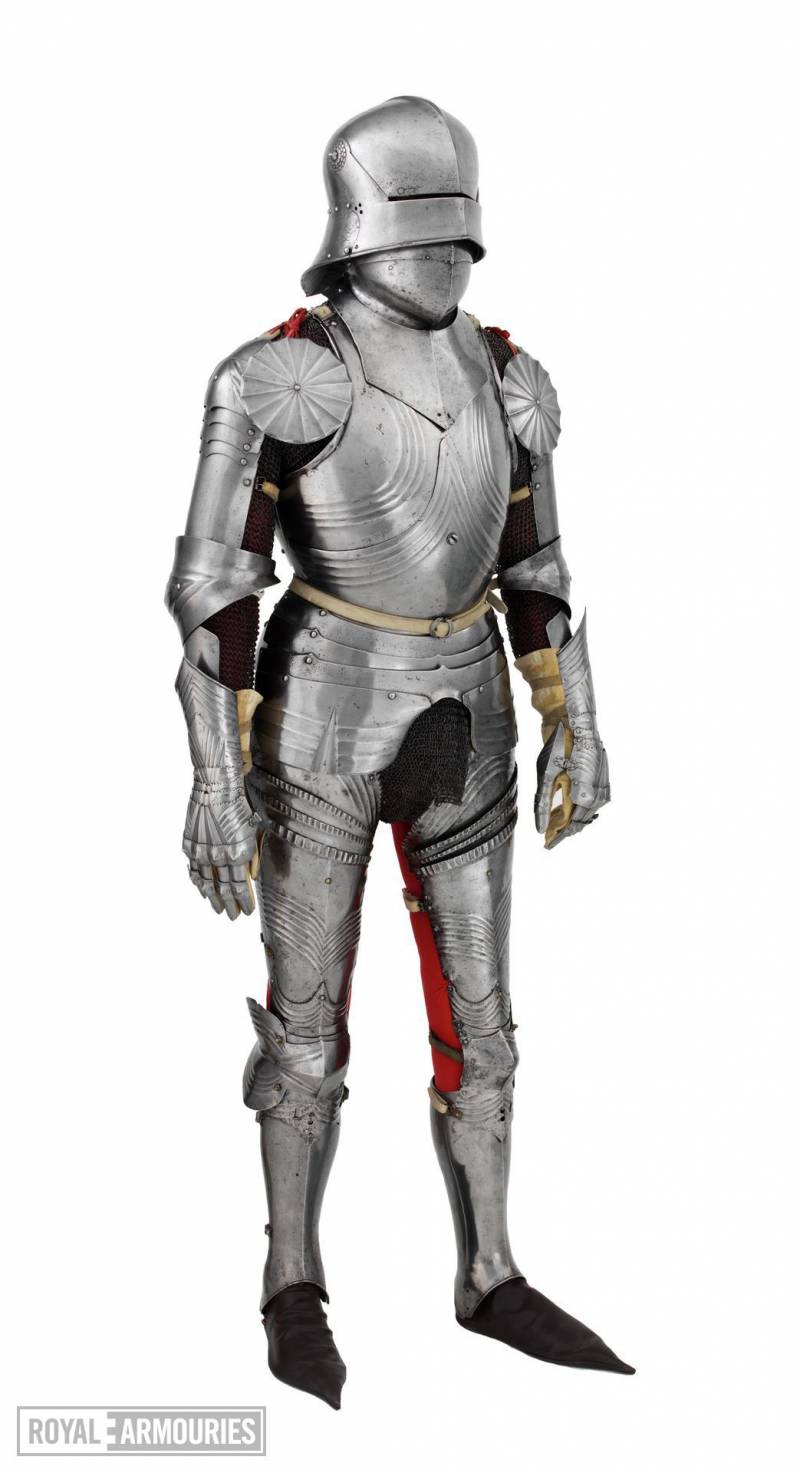
Typical Gothic armor of 1480. Salad helmet with a long headguard. Equipped with a visor with one continuous viewing gap. Has a forerunner - bevor. The chest armor is a cuirass, made of two parts, connected with a rivet, with V-shaped grooves in the center and horizontal grooves on both sides. Besagu - round, profiled. The sash is a “skirt” of four plates to protect the lower back and buttocks, which are connected by hinges, which gave this part a certain mobility. Sinks with fluted openers. Mittens with fingers and long cuffs with shells, also grooved. Polens with large corrugated wings. The greaves are smooth. Pointed toe sabatons are a reconstruction. Dimensions: total height - 1740 mm. Weight 18,16 kg. On the upper breast plate on the right side is the hallmark of an Innsbruck master, Klaus Wagner. Metallographic analysis showed the presence in the metal of characteristic microstructures of ferrite, perlite, as well as several large slag inclusions. Perlite is concentrated on the outer surface, although it partially mixes with ferrite deep in the metal plates. There is a clear concentration gradient of perlite near the surface, which indicates that the armor material is a low-carbon steel that has been annealed but not quenched (Royal Arsenal, Leeds, UK)
Meanwhile, in the center of the French franc, the Archers attacked the Flemish infantry, but they resisted very stubbornly, especially since more than two hundred dismounted nobles led by Prince Maximilian himself fought among them. There were about 11000 Flemings and the battle on this site took on a very fierce character. Moreover, Maximilian with a lance in his hands took a place in their row, which, of course, could not but inspire their enthusiasm. Bristling with peaks in the manner of the Swiss, they steadfastly held their defenses, while archers and arquebusiers showered the enemy with arrows and bullets. Ordonance companies of the French several times tried to break through their system in different places, but they did not succeed. The French could not oppose them. The fact is that they did not have their own Swiss, because shortly before that, the Swiss cantons announced that they were leaving the war. Louis XI was allowed to recruit only 6000 people, but they were all sent to Franche-Comté.
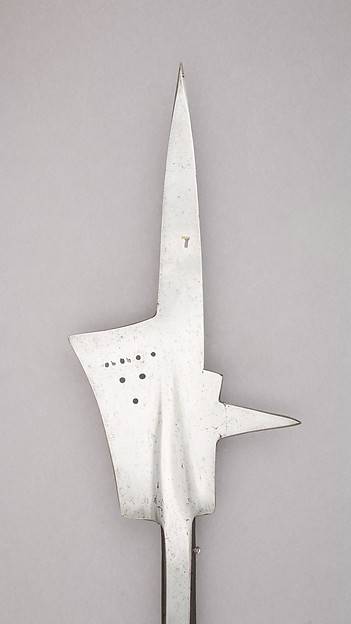
Halberd 1450. Switzerland. Weight 2550 g (Metropolitan Museum of Art, New York)
Under a hail of arrows and bullets, the ordonance companies and free arrows gradually began to retreat, and Maximilian already ordered the pursuit, but here the garrison of Teruana undertook a sortie. However, instead of hitting the rear of the army of Maximilian, they rushed to rob the Flemish convoy, and in addition they also committed the ruthless massacre of the patients who were in the convoy, as well as women and children who prevented them from enriching themselves at someone else's expense.
The French tried to use their cannons to break up the Flemish ranks, but here the Count de Romon, who commanded the right flank of Maximilian, using the disorder that prevailed in them, went around their building and burst into the camp. Panic began, the French fled, so even their gendarmerie, which just at that time began to return from the chase, could not stop them. In addition, the riders returned to the battlefield in small groups, or even completely alone, and could not in any way organize a well-coordinated rebuff to the fleming Flemings.
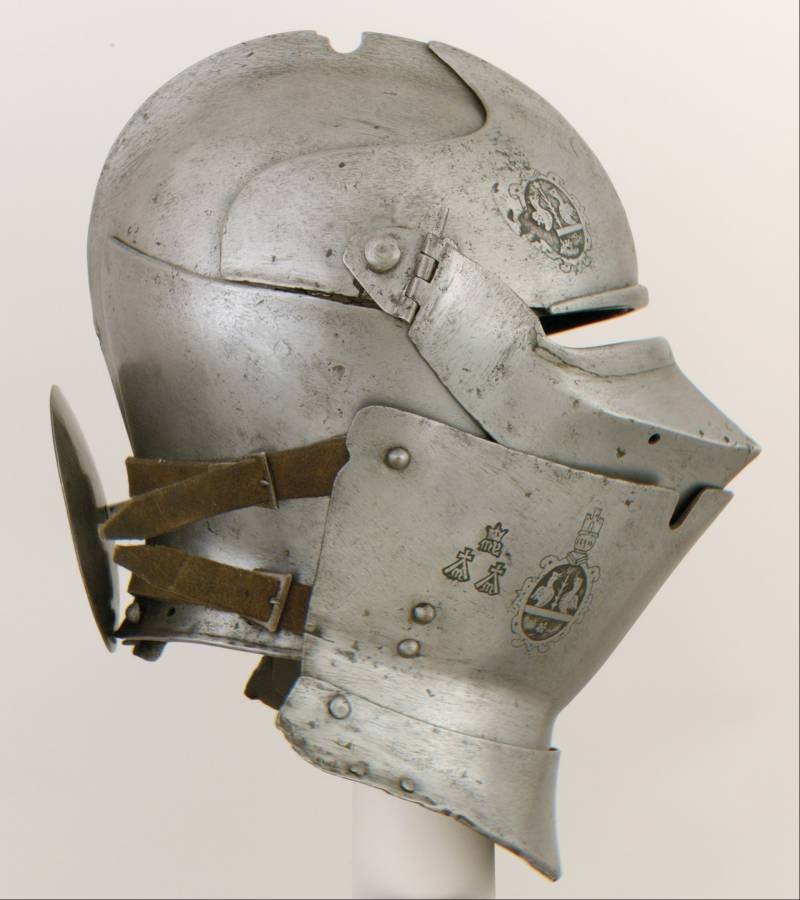
Arme helmet, approx. 1460-1470 The helmet has the stigma of the Milanese gunsmiths of the Missaglia family. Height 30,5 cm. Weight 3603,2 g. Weight with a gorget and a foreskin 5406,3 g (Metropolitan Museum of Art, New York)
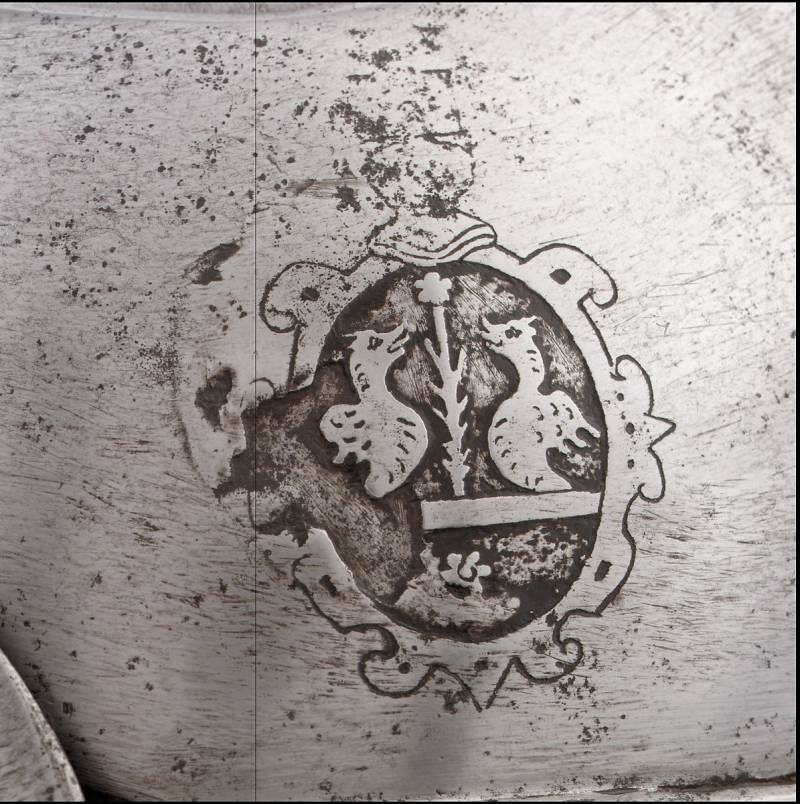
The coat of arms of the Piombini family on the visor of the helmet, which apparently belonged to this helmet
As a result, in this battle, which lasted from two o'clock in the afternoon until eight in the evening, Maximilian managed to win, although it came to him at a high price. Almost all the gendarmes of his cavalry were killed or captured. And in general, the Flemings lost more than the French. After the battle, Krevker quickly gathered his scattered troops. However, Louis XI took the defeat suffered as a real disaster. True, only because he considered that his courtiers had not told him the whole truth.
But then he ordered the victory to be announced in all his cities, although the Teruana garrison reprimanded through the Commander-in-Chief Count Krevkor that the battle would indeed have been won if they had hit the army of Maximilian and not robbed his convoy, and that the brutalities of the soldiers against civilians only result in the same atrocity. However, it was already positive that he condemned such actions, and then decided to begin peace negotiations with Maximilian and defeat him, if not by force of arms, then by diplomacy.
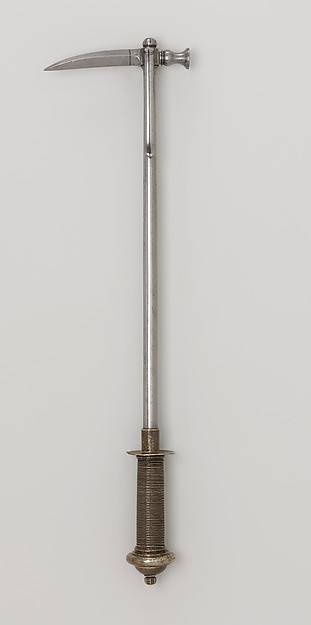
Klevets. It was a common weapon of riders in the XV-XVII centuries. since it allowed to pierce the armor of cuirassiers and reitars (Metropolitan Museum of Art, New York)
And Maximilian did not have the strength to develop his success. He could not even take Teruana and, although the battlefield remained behind him, did not take further military action and even dismissed his troops. There is an assumption that his treasury was simply empty and he could not pay the troops necessary to capture Teruana.
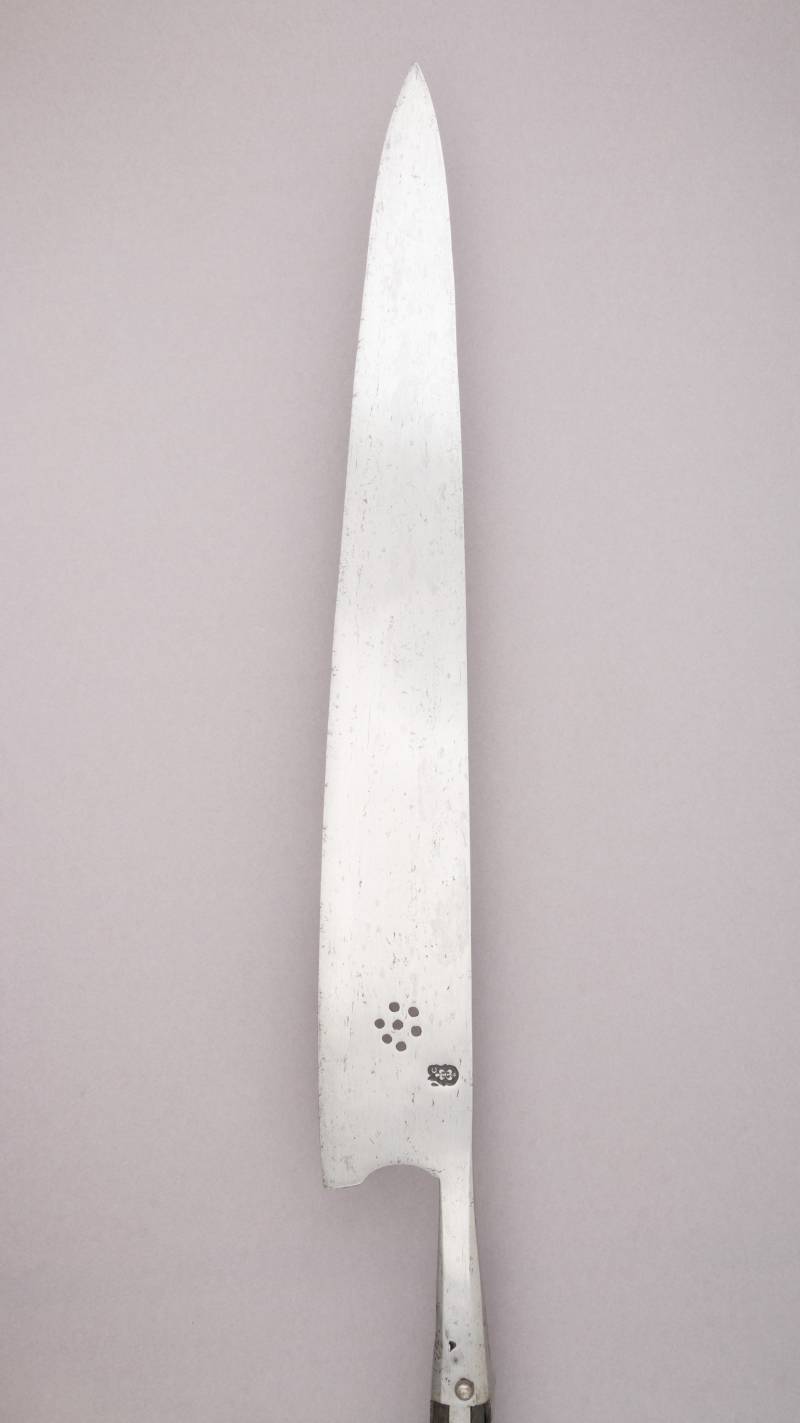
Coase. A long blade on a spear shaft made it possible to strike and stabbing. Popular in the XNUMXth century infantry weapons. (Metropolitan Museum of Art, New York)
So the battle of Ginegat as a political event remained a "dummy", a massacre of people and horses, and no more. But from a military point of view, the use of it was great, since it clearly showed that no cavalry of the armored men was capable of breaking through a dense mass of infantry with peaks and halberds, which in addition was supported by numerous arrows. Well, the Dutch infantry, so successfully fighting the gendarmes at Ginegate, became the obvious forerunner of the Landsknecht infantry.
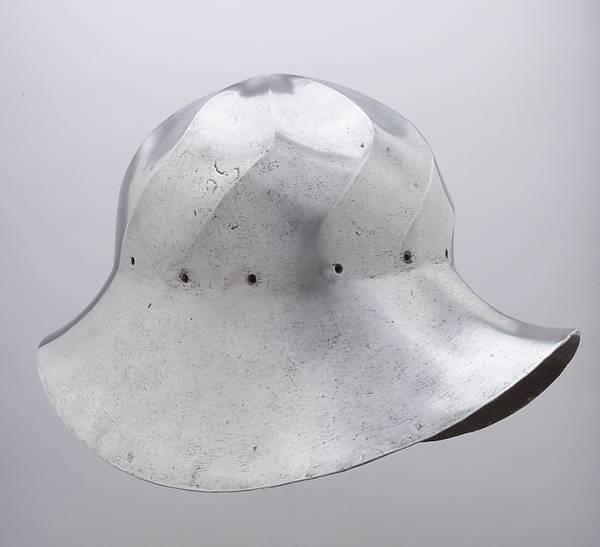
Another iron hat of the era of the battle of Ginegate. OK. 1475 g. Weight 2,920 kg (Metropolitan Museum of Art, New York)
To be continued ...
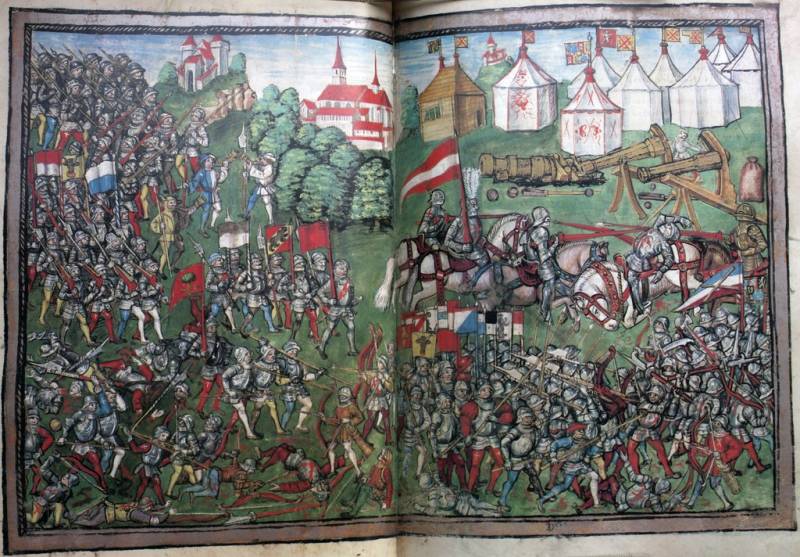
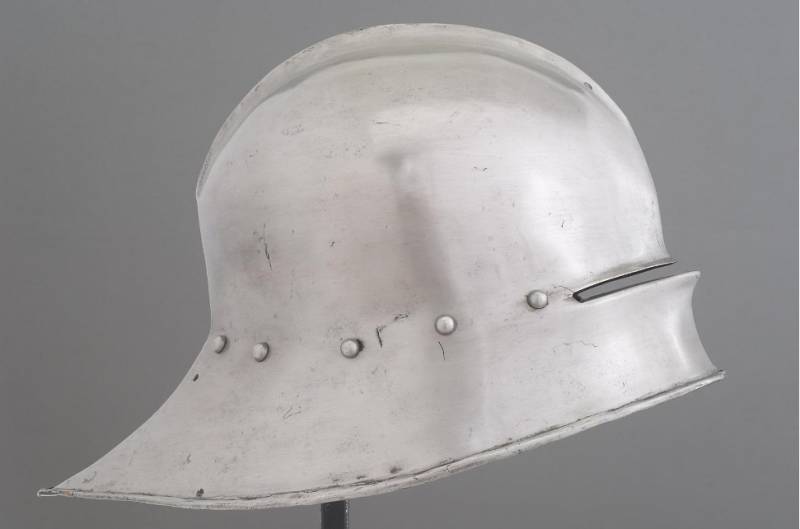
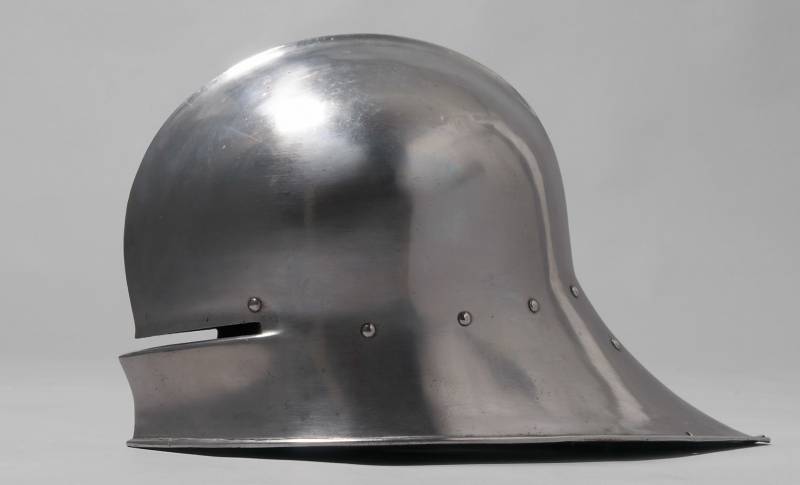
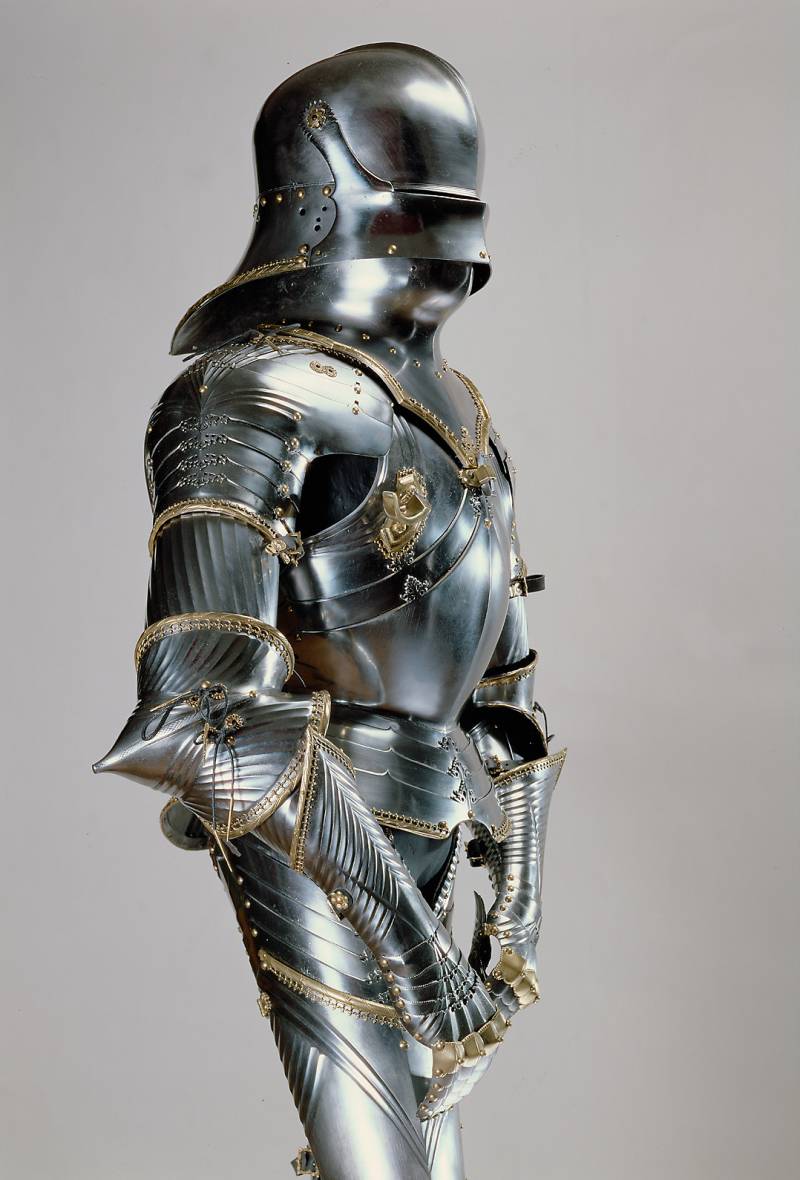
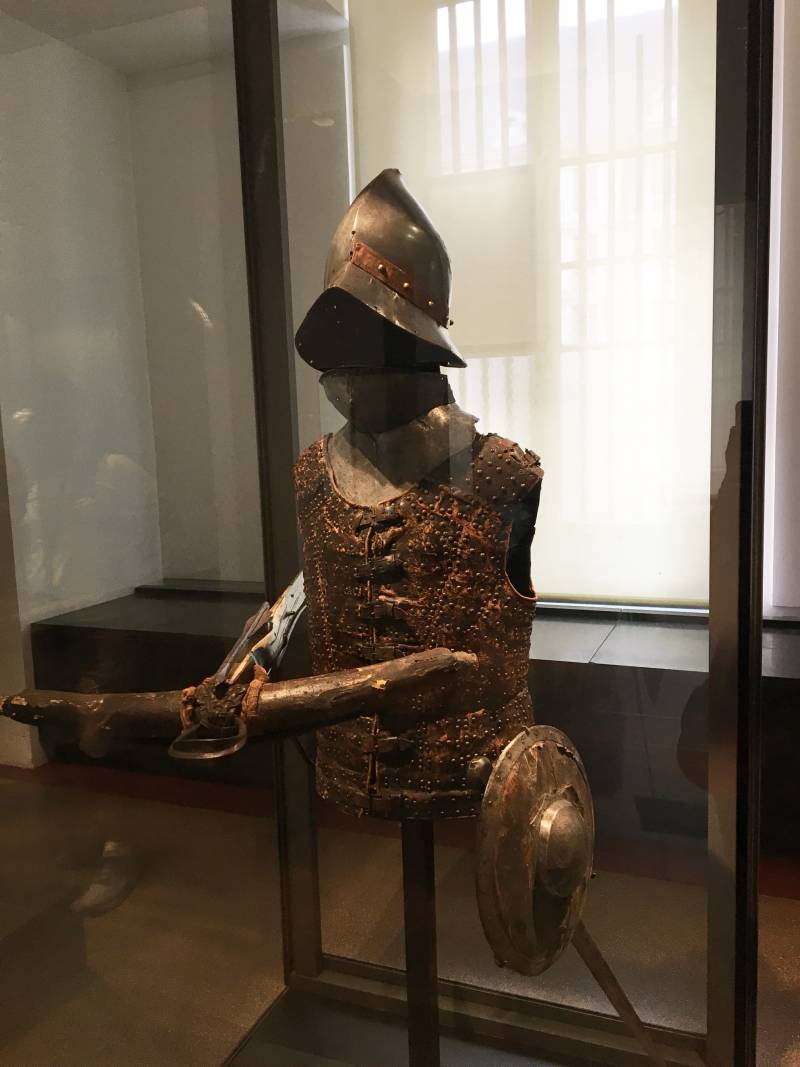
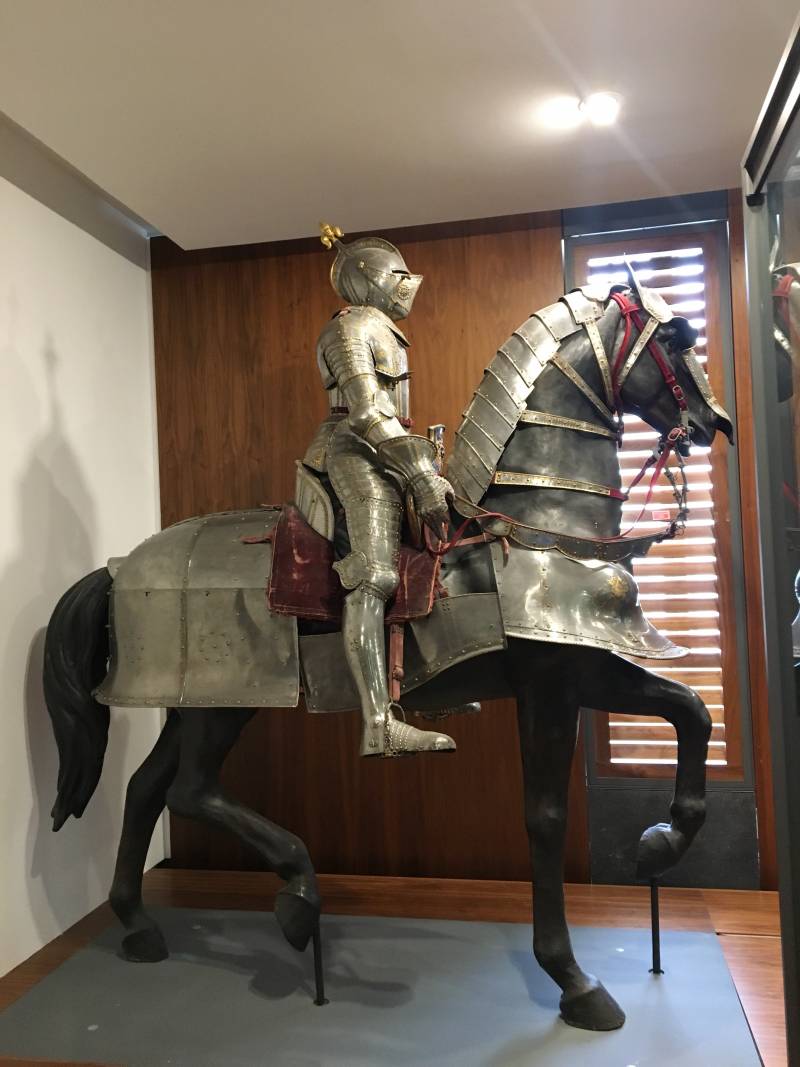
Information